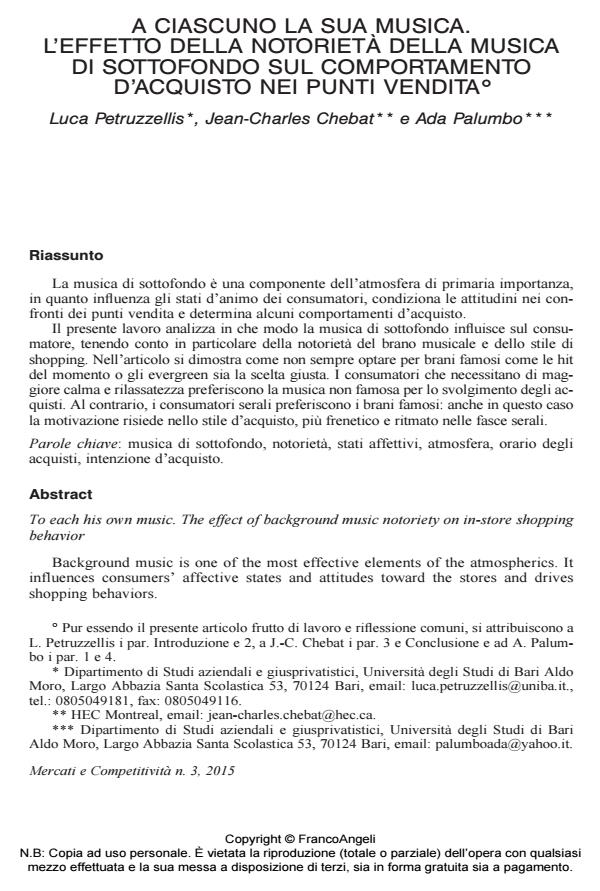A ciascuno la sua musica. l’effetto della notorietà della musica di sottofondo sul comportamento d’acquisto nei punti vendita
Titolo Rivista MERCATI E COMPETITIVITÀ
Autori/Curatori Luca Petruzzellis, Jean-Charles Chebat, Ada Palumbo
Anno di pubblicazione 2015 Fascicolo 2015/3
Lingua Italiano Numero pagine 20 P. 15-34 Dimensione file 570 KB
DOI 10.3280/MC2015-003002
Il DOI è il codice a barre della proprietà intellettuale: per saperne di più
clicca qui
Qui sotto puoi vedere in anteprima la prima pagina di questo articolo.
Se questo articolo ti interessa, lo puoi acquistare (e scaricare in formato pdf) seguendo le facili indicazioni per acquistare il download credit. Acquista Download Credits per scaricare questo Articolo in formato PDF

FrancoAngeli è membro della Publishers International Linking Association, Inc (PILA)associazione indipendente e non profit per facilitare (attraverso i servizi tecnologici implementati da CrossRef.org) l’accesso degli studiosi ai contenuti digitali nelle pubblicazioni professionali e scientifiche
La musica di sottofondo è una componente dell’atmosfera di primaria importanza, in quanto influenza gli stati d’animo dei consumatori, condiziona le attitudini nei confronti dei punti vendita e determina alcuni comportamenti d’acquisto. Il presente lavoro analizza in che modo la musica di sottofondo influisce sul consumatore, tenendo conto in particolare della notorietà del brano musicale e dello stile di shopping. Nell’articolo si dimostra come non sempre optare per brani famosi come le hit del momento o gli evergreen sia la scelta giusta. I consumatori che necessitano di maggiore calma e rilassatezza preferiscono la musica non famosa per lo svolgimento degli acquisti. Al contrario, i consumatori serali preferiscono i brani famosi: anche in questo caso la motivazione risiede nello stile d’acquisto, più frenetico e ritmato nelle fasce serali.
Parole chiave:Musica di sottofondo, notorietà, stati affettivi, atmosfera, orario degli acquisti, intenzione d’acquisto
Luca Petruzzellis, Jean-Charles Chebat, Ada Palumbo, A ciascuno la sua musica. l’effetto della notorietà della musica di sottofondo sul comportamento d’acquisto nei punti vendita in "MERCATI E COMPETITIVITÀ" 3/2015, pp 15-34, DOI: 10.3280/MC2015-003002